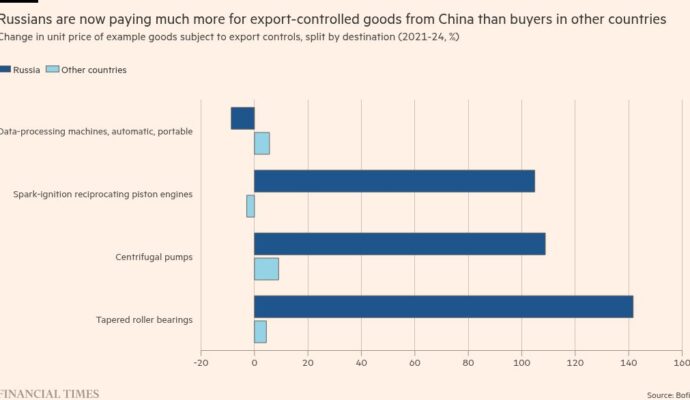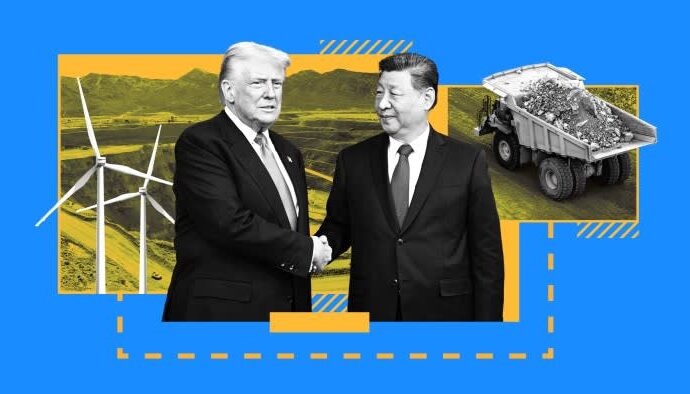
Stay informed with free updates
Simply sign up to the Climate change myFT Digest — delivered directly to your inbox.
The writer is chief executive of the European Climate Foundation and a special envoy to Europe for COP30
When the UN Framework Convention on Climate Change was created in 1992, trade was largely excluded: Article 3.5 of the convention states that “measures taken to combat climate change, including unilateral ones, should not constitute a means of arbitrary or unjustifiable discrimination or a disguised restriction on international trade”. Parties left international debates on trade to the World Trade Organization.
But in 2025, when nearly a quarter of global greenhouse gas emissions are “embodied” — or contained — in internationally traded goods and materials, does this separation still make sense?
Embodied emissions are those that are released in one country or sector to produce goods and services consumed in another. For instance, the embodied emissions of Indian steel are all the direct emissions generated by this sector in India to produce the steel that other economies buy and use. Currently, nationally determined contributions (NDCs) — the emissions targets countries set under the Paris Agreement — are calculated on a territorial basis; in other words, they capture emissions produced within a country’s borders.
But this should not prevent nations from seeking to address emissions that are triggered by their consumption. Realising that “our imports are your emissions” (and vice versa) can create an opportunity for co-operation on lowering them globally.
Imported emissions are increasingly significant in national carbon footprints. In China between 2010 and 2021, imported emissions more than doubled, while domestic emissions increased by 42 per cent. Imported emissions accounted for almost 40 per cent of the EU’s carbon footprint in 2021.
The major emitting countries also happen to be major importers of embodied emissions, with the G20 accounting for 81 per cent of embodied emissions, a reflection of their prominence in international trade. Between them, China and the EU imported 4.3bn tonnes of CO₂ equivalent in 2021 (around 10 per cent of global emissions). If the two committed to reducing their imported emissions, it would make clear that decarbonisation is now central to competing in two of the world’s major markets.
Taking action will require common methods to measure and track emissions embodied in goods. The International Organization for Standardization and the Greenhouse Gas Protocol are trying to do this, the Chinese commerce ministry is planning a carbon footprint database for exports, and earlier this year the BRICS launched a Laboratory for Trade, Climate Change and Sustainable Development. Countries should also set targets on their imported emissions. By focusing on critical emission sources, where reduction efforts are often stymied by international competition, we can hasten global mitigation.
Standards and pricing will be central to unlocking action. For example, a jurisdiction could adopt a greenhouse gas-performance standard for products sold in its market, similar to energy performance standards for appliances. This could be introduced in public procurement contracts to create a market for innovative producers who need a “green premium” to be able to invest in low-carbon production. While this should lead to lower embodied emissions, it could also trigger international trade in low-carbon products.
Meanwhile, border carbon adjustments, like the EU carbon border adjustment mechanism (CBAM), could regulate embodied carbon through a price on imported emissions in specific sectors. While CBAM was controversial for EU trade partners, it did trigger policy change outside the EU, in Turkey and China, where governments pointed to it as a sign to industry that decarbonisation was starting to reshape international markets.
Cooperation to address imported emissions will, of course, have to grapple with differences in policy choices and levels of ambition, as well as the fact that fossil-fuel interests — now backed by the foreign policy of the world’s largest economy — are working hard to slow the green transition. Europe, China, Brazil and India all share a fundamental interest in shaping global markets so they facilitate a green transition rather than lock in fossil-fuel dependence. Working together is their only real chance of withstanding what is likely to be a fierce, no-holds-barred campaign of retributive diplomacy.
Trade policy must become central to the decarbonisation effort. It is one of the strongest levers available to foster a form of globalisation that rewards those who commit and penalises those who cling to fossil fuels.


